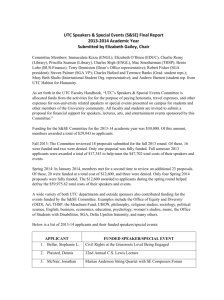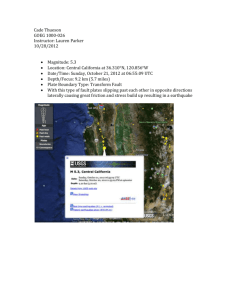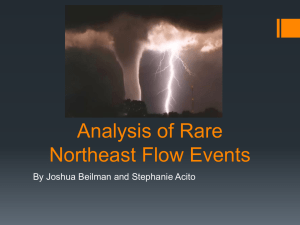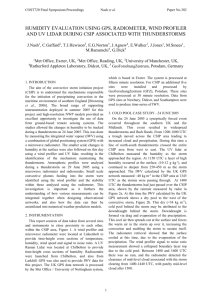high time resolution boundary layer description using combined
advertisement
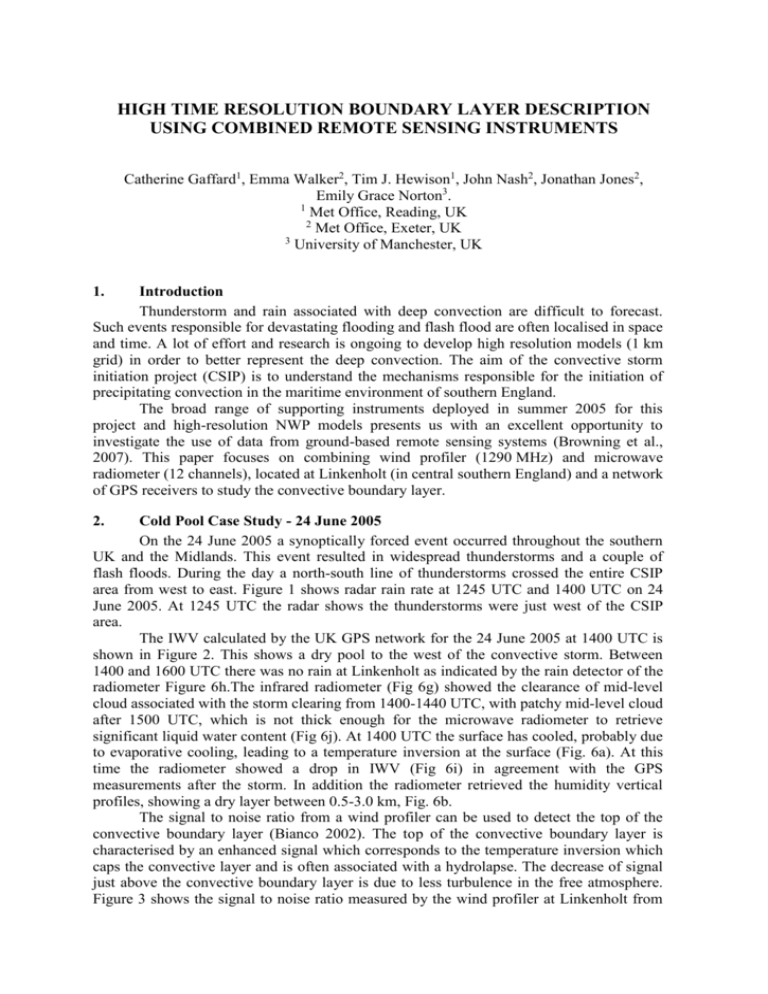
HIGH TIME RESOLUTION BOUNDARY LAYER DESCRIPTION USING COMBINED REMOTE SENSING INSTRUMENTS Catherine Gaffard1, Emma Walker2, Tim J. Hewison1, John Nash2, Jonathan Jones2, Emily Grace Norton3. 1 Met Office, Reading, UK 2 Met Office, Exeter, UK 3 University of Manchester, UK 1. Introduction Thunderstorm and rain associated with deep convection are difficult to forecast. Such events responsible for devastating flooding and flash flood are often localised in space and time. A lot of effort and research is ongoing to develop high resolution models (1 km grid) in order to better represent the deep convection. The aim of the convective storm initiation project (CSIP) is to understand the mechanisms responsible for the initiation of precipitating convection in the maritime environment of southern England. The broad range of supporting instruments deployed in summer 2005 for this project and high-resolution NWP models presents us with an excellent opportunity to investigate the use of data from ground-based remote sensing systems (Browning et al., 2007). This paper focuses on combining wind profiler (1290 MHz) and microwave radiometer (12 channels), located at Linkenholt (in central southern England) and a network of GPS receivers to study the convective boundary layer. 2. Cold Pool Case Study - 24 June 2005 On the 24 June 2005 a synoptically forced event occurred throughout the southern UK and the Midlands. This event resulted in widespread thunderstorms and a couple of flash floods. During the day a north-south line of thunderstorms crossed the entire CSIP area from west to east. Figure 1 shows radar rain rate at 1245 UTC and 1400 UTC on 24 June 2005. At 1245 UTC the radar shows the thunderstorms were just west of the CSIP area. The IWV calculated by the UK GPS network for the 24 June 2005 at 1400 UTC is shown in Figure 2. This shows a dry pool to the west of the convective storm. Between 1400 and 1600 UTC there was no rain at Linkenholt as indicated by the rain detector of the radiometer Figure 6h.The infrared radiometer (Fig 6g) showed the clearance of mid-level cloud associated with the storm clearing from 1400-1440 UTC, with patchy mid-level cloud after 1500 UTC, which is not thick enough for the microwave radiometer to retrieve significant liquid water content (Fig 6j). At 1400 UTC the surface has cooled, probably due to evaporative cooling, leading to a temperature inversion at the surface (Fig. 6a). At this time the radiometer showed a drop in IWV (Fig 6i) in agreement with the GPS measurements after the storm. In addition the radiometer retrieved the humidity vertical profiles, showing a dry layer between 0.5-3.0 km, Fig. 6b. The signal to noise ratio from a wind profiler can be used to detect the top of the convective boundary layer (Bianco 2002). The top of the convective boundary layer is characterised by an enhanced signal which corresponds to the temperature inversion which caps the convective layer and is often associated with a hydrolapse. The decrease of signal just above the convective boundary layer is due to less turbulence in the free atmosphere. Figure 3 shows the signal to noise ratio measured by the wind profiler at Linkenholt from 1400-1600 UTC on 24 June 2005. The top of the boundary layer is shown by the black line. This had collapsed due to the cold pool generated by the rain, and then increased in height from 1430 UTC onwards, as the surface warmed by solar heating .The strong signal after 1400 UTC was due to precipitation from higher up (above 7 km), but range aliased to appear between 0-3 km. The cloud radar located at Chilbolton (20 km south) indicated a deep cumulonimbus reaching the tropopause (Figure 4). Figure 5 shows another example of collapses of the boundary layer on another day characterised by heavy rain. On that day, the height of the boundary layer decreased by 600 m after 1100 UTC. However, the rain event at 1330 UTC was weaker than at 1045 and 1215 UTC and didn’t really affect the thermal mixing in the convective boundary layer. On 24 June the dry, cold air behind the storm may be attributed to a downdraught formed via drag and evaporation of the precipitation. This cool air then spreads out at the surface and forces the warm air in the storm to rise over it, increasing the convection and enabling the storm to sustain itself. Figure 1 Radar rain-rate for 24 June 2005 for (a) 1245 UTC and (b) 1400 UTC 3. Convective Thermals The vertical wind speed measured on 29 June 2005 1600-1700 UTC shows ascent of 0.5 m s-1 from the surface to about 1.3 km, Figure 8a. On either side of this updraught vertical wind speed of -0.6 m s-1 was measured in the downdraughts. Above the top of the thermal, the vertical speed was also negative as air from above was being funnelled into the downdraught. The signal to noise ratio produced by the wind profiler shows the change in humidity occurring between the boundary of the updraught and the surrounding downdraughts, Figure 8b. A zoomed in diagram of the retrieval by the microwave radiometer at Linkenholt on the 29 June 2005 1600-1700 UTC is shown in Figure 7. (Note the radiometer time was found to be 5m 21s slow with respect to the wind profiler by comparing the timing of the start of a rain shower on this day.) This plot helps to analyse the atmospheric conditions which lead to the convective plume, identified in Fig. 8. The wind profiler plot shows the plume initiated at 1628 UTC. Fig. 7d shows the surface temperature gradually increased from 18.2 to 19.3 ºC at 1628 UTC, which may have triggered the convection forming the updraught. The temperature profile in Fig. 7a shows unstable conditions with a large temperature gradient, near the surface at 1633 UTC, before the updraught. The temperature profile in Fig. 7a then shows stable, well-mixed conditions, with a smaller temperature gradient during the warm updraught. = Lightning measured using arrival time difference (ATD) Winds at 2 km 36 34 Figure 2 GPS integrated water vapour processed by the Met Office/University of Nottingham system, 24 June 2005, 1400 UTC. Contours give values of IWV in kgm2. The values in white are obtained from each GPS receiver. Figure 3 Signal to noise ratio measured by the wind profiler at Linkenholt 24 June 2005, 1400-1600 UTC. The top of the boundary layer is marked with a black line. Figure 5 Signal to noise ratio measured by Figure 4 Cloud radar reflectivity from the wind profiler at Linkenholt 25 August Chilbolton 24 June 2005 , 0000-2400 UTC 2005, 0900-1500 UTC Figure 7 Figure 6 Figure 6,7: Microwave radiometer retrieval showing (a) temperature, (b) relative humidity and (c) liquid water time-height cross sections for 0-4 km height , 24 June 2005, 1400-1600 UTC. (Figure 6) 0-1 km height, 29 June 2005, 1600-1700 UTC.(Figure7) Time series of scalars are also shown in red for (d) surface temperature, (e) surface relative humidity, (f) pressure, (g) infrared brightness temperature, (h) rain sensor, (i) integrated water vapour and (j) integrated liquid water. The relative humidity (Fig. 7b) was lower during the updraught (60-75 %), due to its higher temperature. The conditions remained stable until the end of the updraught. Fig. 7i also shows there was IWV build up before the updraught, then released, although this could be associated with the presence of low clouds (Fig. 7j).At 1631 UTC this low cloud cleared, allowing insolation to heat the surface to initiate convection. a b Figure 8 (a) Vertical speed and (b) signal to noise ratio, from wind profiler at Linkenholt 29 June 2005 1600-1700 UTC. 4. Conclusion The dense network of GPS sensors allowed the identification and tracking of areas of drier/colder air, which are associated with the lifecycle of thunderstorms. The radiometer and the wind profiler confirm the presence of dry, cold air behind the storm. The wind profiler allows us to follow in detail the height of the convective boundary layer with clear reduction of the mixing layer after downpours. This information is important for model validation as this parameter is a function of the temperature, heat and moisture fluxes, and turbulences (Stull 1988). Inter-comparison between the cloud radar and the wind profiler allowed detection of range aliasing in the wind profiler. The inter-comparison between wind profiler signal to noise and microwave radiometer temperature and humidity profiles showed updraught development that could probably be used to validate large eddy simulation model. The duration of the updraughts observed was in the range five to ten minutes with downdraughts identified on either side. References K. A. Browning et al., 2007: The Convective Storm Initiation Project, Accepted for Bulletin Am. Meteorol. Soc Bianco, L., and J. M. Wilczak, 2002: Convective boundary layer mixing depth: Improved measurement by Doppler radar wind profiler using fuzzy logic. J. Atmos. Oceanic Technol., 19, 1745–1758 Stull, R. B., 1988: An Introduction to Boundary Layer Meteorology. Kluwer Academic, 666 pp.






